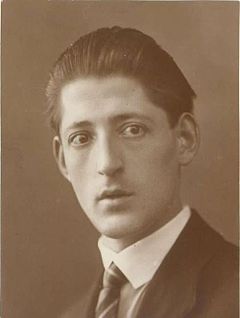- Miran Jarc
-
Miran Jarc 
Born 5 July 1900
Črnomelj, Austria-Hungary (now Slovenia)Died 24 August 1942
Pugeld, Kočevski RogOccupation writer, poet, playwright Notable work(s) Človek in noč, Novembrske pesmi, Lirika, Novo mesto Miran Jarc (5 July 1900 – 24 August 1942) was a Slovene writer, poet, playwright and essayist.[1]
Jarc was born in the town of Črnomelj in White Carniola, in what was then Austria-Hungary in 1900. He was sent to school in Novo Mesto, and between 1918 and 1922 studied Slavic philology in Zagreb and Ljubljana, though he never completed his studies. From 1923, he worked as a bank clerk in Ljubljana. He started writing whilst still a student and published his first poem in the journal Ljubljanski zvon in 1918.[2] In the 1930s, he also worked as an actor and violinist in the Slovenian Marionette Theater in Ljubljana.
In 1942, during World War II, he was arrested by the occupying Fascist Italian authorities and sent to the internment camp at Gonars, but the train transporting the prisoners was attacked by partisans near Verd and the detainees freed. Jarc joined the partisans and was killed in fight by the Italian Army two months later in Pugeld near Stari Log in Kočevski Rog.
The public library in Novo Mesto[3] and a primary school in Črnomelj[4] are named after Jarc.
Personality and work
Jarc started his literary career in the late 1910s in Novo Mesto, which emerged at the time as an important literary center. As a young student, he joined the literary-artistic circle around the painter Božidar Jakac and poet Anton Podbevšek. Together, they organized a cultural-artistic manifestation, known as the Novo Mesto Spring. During this period, Jarc became interested in antroposophy and developed an interest in Buddhism. However, he later grew closer to Christianity, remaining a member of the Roman Catholic Church.
In the 1920s, Jarc emerged as one of the most prominent expressionist poets in Slovenia. Recurrent themes in his poetry were the search of an exit from a sinking civilization. To the crisis of European civilization and the mechanization of man, he juxtaposed to an ecstatic and lyrical personal reflection. In the 1930s, he grew closer to Social Realism.
One of his most important works is the autobiographical novel Novo Mesto (1932), in which he described the intellectual and artistic turmoil in the small Lower Carniolan town in the first years after World War One.
Selected works
- Človek in noč, "Man and the Night", poems (1927)
- Novembrske pesmi, "November Poems", poems (1936)
- Lirika, "Lyrics", poems, (1940)
- Novo mesto, autobiographical novel (1932)
References
- ^ "Novo Mesto Municipality site" (in Slovene). Miran Jarc. Novo Mesto Municipality. http://www.novomesto.si/si/novomesto/obcina/osebnosti/jarc/. Retrieved 27 October 2011.
- ^ Helga Glušič, Sto Slovenskih Pripovednikov (Ljubljana: Prešernova družba, 1996) ISBN 961-6186-21-3
- ^ Library Building site
- ^ Miran Jarc Primary School Črnomelj site
Categories:- 1900 births
- 1942 deaths
- Slovenian writers
- Slovenian poets
- Slovenian partisans
- People from Črnomelj
- Slovenian writer stubs
Wikimedia Foundation. 2010.
